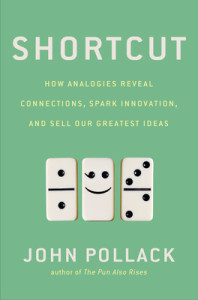Analogies Are the Power Tools of Persuasion
 If you’re looking to make your persuasive communications more effective and efficient, a powerful tool is to master the use of analogy, as explained in a delightful book: Shortcut: How Analogies Reveal Connections, Spark Innovation, and Sell Our Greatest Ideas
If you’re looking to make your persuasive communications more effective and efficient, a powerful tool is to master the use of analogy, as explained in a delightful book: Shortcut: How Analogies Reveal Connections, Spark Innovation, and Sell Our Greatest Ideasby John Pollack.
Analogies are like the water that surrounds a fish: we don’t notice them but they are essential to the way we think and communicate. But it’s helpful to pay attention to analogies because they are powerful tools for persuasive communication; they’re essential to the way we think, learn, and react to new information.
Analogies work because our brains are hardwired to learn from experience and to make judgments with as little hard thinking as we can get away with. As we gain experience in the world, we build mental models of what works or doesn’t work, and what is good or bad. So whenever we encounter new information, we try to make sense of it by comparing it to something familiar. In essence, we choose an appropriate analogy from our vast internal database—usually instantly and unconsciously—and that colors how we react to the new information. Because there can be many familiar situations that might apply, the persuader who chooses the analogy for us creates an easy shortcut for us to take. An astute persuader chooses the best analogy; he does not leave the choice up to the recipient.
According to Pollack, there are five ways that analogies affect the persuasiveness of your ideas:
- Like a native guide in a strange land, they use the familiar to explain the unfamiliar. This is the most obvious function of analogy, and it’s particularly useful in reducing the perceived risk of new ideas.
- Like magicians who direct your attention for maximum effect, they highlight some things and hide others. They help you frame your message in the best possible light.
- They identify useful abstractions and make them concrete so that we can grasp and remember them easier. When FDR faced the difficult task of selling the American people on providing aid to Britain through Lend-Lease, he compared it to lending your neighbors your garden hose when their house is on fire.
- They tell a coherent story. In fact, an analogy is a distilled form of a story, and most stories are just extended analogies.
- They resonate emotionally. The feelings associated with the familiar transfer over to the new.
Analogies are subtle; they’re like the spoonful of sugar which makes it easier to swallow a difficult message—they help you bypass the normal reaction that people have against being told what to do. Analogies are vivid, which helps people remember your key points later on when they use the information you’ve provided to make their decision.
Most of all, analogies are powerful; once they’ve taken hold, they’re difficult to eradicate. It’s true that people who disagree with you may dispute your analogy, but there is definitely a first-mover advantage: if the analogy resonates, it’s difficult to fight it, even when they can point out flaws. An excellent example described in the book was used by John Roberts during his Senate hearings when he was nominated for Chief Justice. Roberts knew that Democratic Senators would challenge his fairness, so he opened by comparing himself to a baseball umpire; his point was that an umpire does not make the rules, he enforces them, and he does so fairly and impartially. Although then-Senator Biden pointed out that as Chief Justice, he would in fact be the one making the rules, the analogy had already taken hold. (If your opponent gets their analogy out first, it’s usually not enough to refute it. You have to fight fire with fire and come up with a better analogy of your own.)
The John Roberts example is just one of dozens that Pollack recounts in the book and which make it a pleasure to read. Read this book and you will be better able to tap into hidden superpowers of persuasion you might not even know you have.





This is a very important topic. About it I have found very interesting the book “Yes! 50 secrets from the science of persuasion” written by Goldstein, Martin and Cialdini (https://biasandbelief.wordpress.com/2008/01/08/50-secrets-from-the-science-of-persuasion/) and the following article:
http://www.b2bsell.com/say-yes-50-secrets-science-persuasion/
Thanks for the article!
Sounds pretty darned close to what “positioning” is and how it can be used by presenting the familiar with the unfamiliar